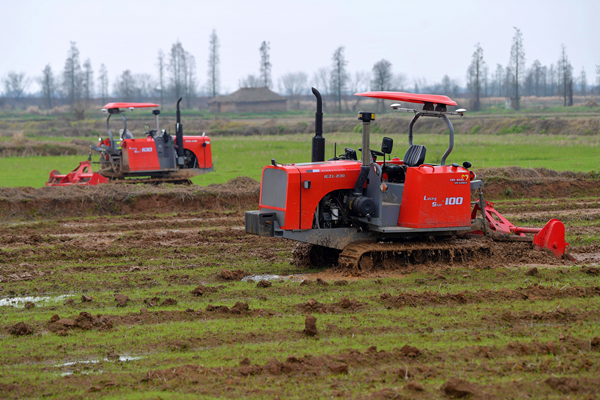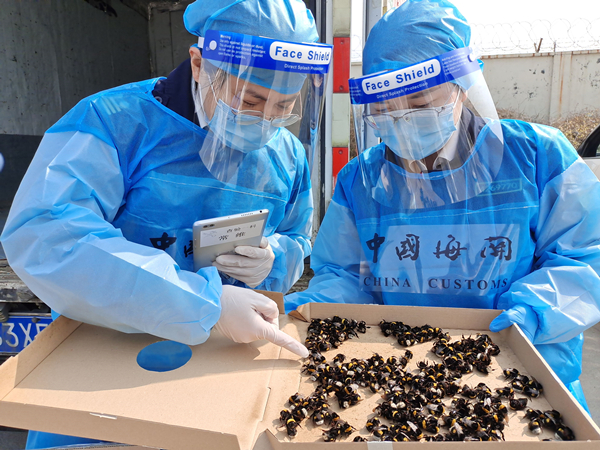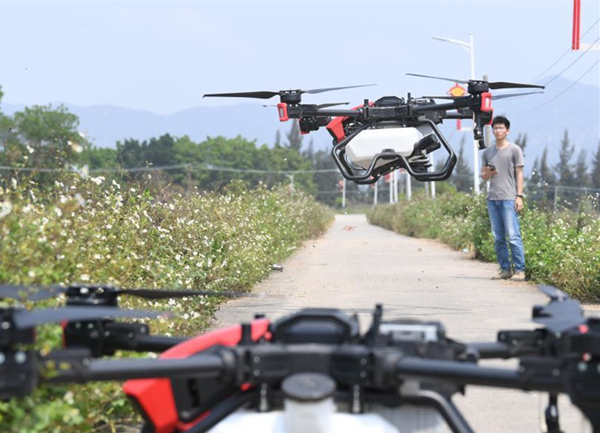China's spring farming goes high-tech thanks to modern agricultural technologies, machines
Modern agricultural technologies and machines are now largely at work in China, facilitating the country's farming activities as spring plowing begins to unfold across its rural landscape.
During the spring plowing season, east China's Anhui province took the lead in deploying satellite remote sensing technology in order to grant loans to farmers, provided in collaboration with MYbank, an online digital bank.

A major grain grower shows the scope of his farmland on his mobile phone in Mengcheng county, east China's Anhui province. (People's Daily Online/Yang Saijun)
After farmers confirm the size of their farmland by tracing its boundaries on a maps app on their mobile phones, the bank will accurately identify the potential growth of the crops and estimate their yields with the help of satellite remote sensing images of the farmland, in this way granting credit to farmers corresponding to the value of their production.
Farmers in all 16 major grain-producing counties in the province can apply for spring farming loans and enjoy an interest-free period for up to two months after applying on their mobile phones during the plowing season. Yu Kai, a major grain grower in Anhui's Mengcheng county, received a spring farming loan of 290,000 yuan ($44,570) to buy chemical fertilizers and lease agricultural machines.

Photo shows unmanned rotary cultivators in a field of the Datian rural cooperative in Jiangxiang town, Nanchang county, east China's Jiangxi province. (Photo/Xinhua)
In the province's Changfeng county, agricultural scientists developed a pest recognition system to help farmers handle pests more precisely. It's a selfie stick-like device equipped with a camera to capture images of pests, as well as temperature and moisture sensors and a navigation system.
Using AI technology, the system can automatically identify the type and number of pests as well as any crop diseases according to the images captured by the tool, said Du Jianming, a researcher of the Institute of Intelligent Machines at the Chinese Academy of Sciences. Du claimed that the system could identify more than 400 different pests.

Officers from Qingdao Customs in Qingdao, east China's Shandong province, check bumblebees imported for artificial pollination at vegetable greenhouses. (Photo/Science and Technology Daily)
In Jiangxiang town, Nanchang county of east China's Jiangxi province, farms at the Datian rural cooperative greeted a "smart" spring plowing season on March 12, during which unmanned plowing machines and agricultural drones were deployed to advance new solutions for modern agriculture in China. With the help of these new technologies, only 26 people will be needed to manage 10,000 mu (about 666.67 hectares) of farmland.
Another rural cooperative in Shanggao county, Yichun city in Jiangxi, has established automated greenhouses for raising seedlings, which when brought into operation will reduce farmers' financial and labor burdens by assisting in the cultivation of early rice seedlings before planting.
Lu Yong, a major rice grower in the county, has already placed an order for rice seedlings from the cooperative. “I can plant rice seedlings with a transplanter,” said Lu, who contracted 300 mu of rice paddies this year.
Modern agricultural machines, including highly efficient water-saving irrigation equipment, rotary cultivators, agricultural drones, transplanters, and unmanned tractors, have also been deployed to help farmers in completing their spring farming across China.

Photo shows a transplanter growing vegetables in a field in Taibai county, northwest China's Shaanxi province. (Photo/Shaanxi Daily)
South China's Guangdong province will use rotary cultivators to plow over 12 million mu of farmland and put 450,000 machines and over 1,500 agricultural drones into operation during this year's spring plowing season, according to incomplete statistics from the province's department of agriculture and rural affairs.
Lianshan County in Guangdong has built a digital platform to automatically collect data, such as meteorological conditions, pesticide and fertilization use in fields, and so forth. The data, analyzed via a big data center, will help farmers make decisions, including what kind of fertilizers and pesticides to use, and when to irrigate their farmlands.

A staff member operates an agricultural drone in Jiaoyi village, Taishan city, south China's Guangdong province. (Photo/Xinhua)
Self-driving tractors aided by the BeiDou navigation satellite system have been used to explore precision farming in sugarcane fields at a modern agricultural industrial park in Laibin city, south China's Guangxi Zhuang autonomous region.
Now, the rate of mechanization for the plowing, sowing, and harvesting of sugarcane in the city is about 65 percent, said Mo Tingjin, an agricultural official of Laibin.
In a rural cooperative in Taibai county, northwest China's Shaanxi province, rotary cultivators, drones and other machines were deployed to improve spring farming efficiency. The cooperative also established a smart organic vegetable base, where agricultural technicians can use mobile phones to monitor real-time temperatures, humidity and lighting conditions, and control sun shield, irrigation and fertilization systems in greenhouses.
Photos
Related Stories
- Unmanned farm projects boost development of smart agriculture in China
- China's agricultural province achieves industrial upgrade with innovation
- China to fully advance rural vitalization, facilitate modernization of agriculture, rural areas
- Embracing technology: How Internet transforms rural economy in China
- Chinese scientists breed new crop varieties to support food security
- Chinese vice premier stresses work concerning livestock, poultry breeding
- Chinese olive farmers find money does grow on trees
- Virus-hit Shijiazhuang ensures heating, gas supply
- China deploys large UAV for ecological protection
- Winter fishing festival reels in tourists to Inner Mongolia
Copyright © 2021 People's Daily Online. All Rights Reserved.










